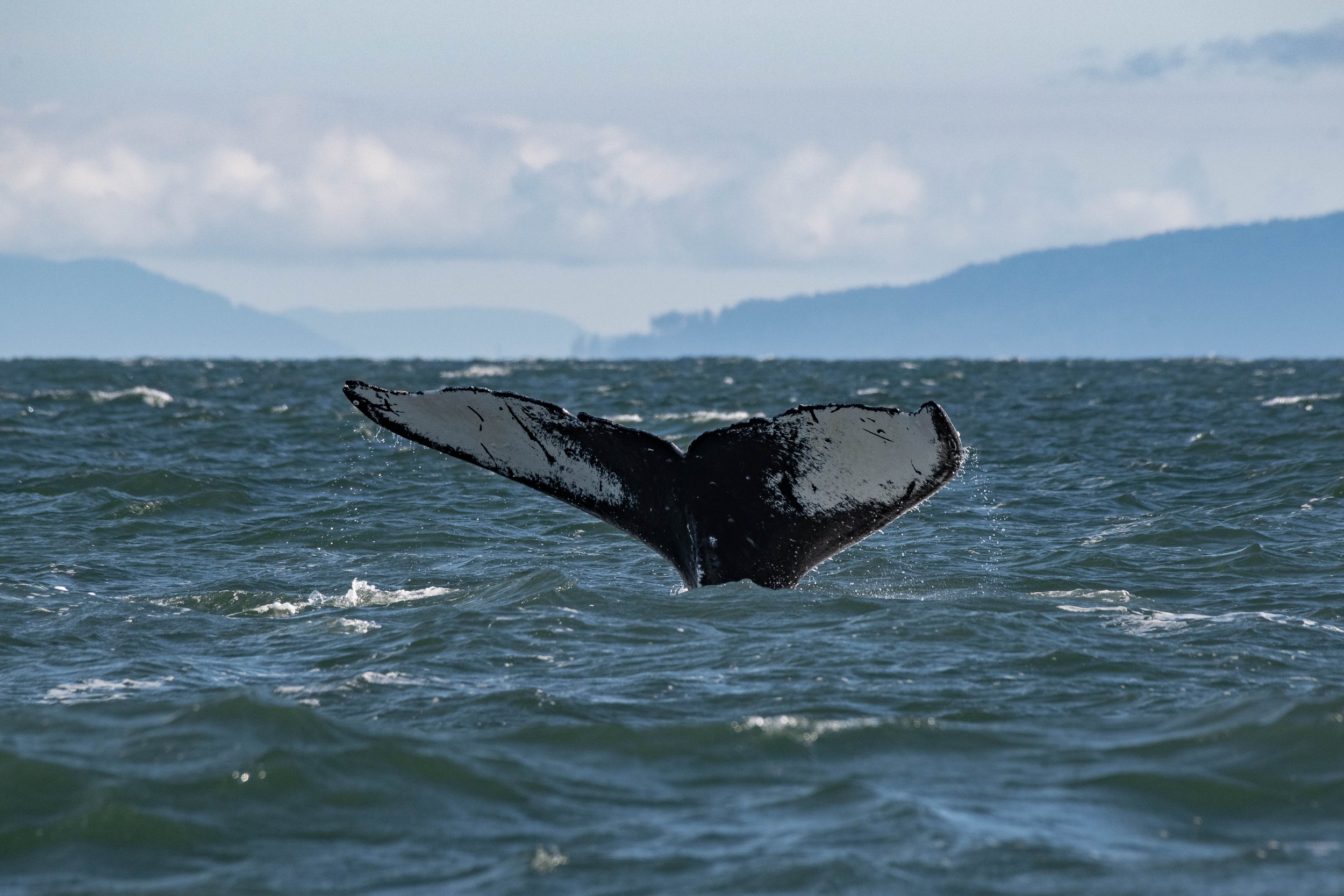October 10, 2024 - A couple of pairs of Humpbacks!
With an early report of a few whales spotted from shore, we were eager to push off the dock and start our search. As our Semi-covered boat Kula departed they turned northwards and began scanning the horizon. We only had to travel for around 20 minutes before we spotted our first sign of whales - a big bushy blow could be seen, signalling the presence of a humpback whale. As we approached we noticed a second big bushy blow - we had found a pair of humpbacks travelling together!
Our on-board naturalist pulled out her camera and after a few quick shots identified this pair as Yogi (BCY0409) and Twinning (BCX1207), using their distinct tail flukes. While Yogi gave us a good angle of their whole fluke, Twinning tended to fluke a bit to the side. This is okay though - we confirmed their identity by their trailing edge, or the outer edge of their flukes which tends to be jagged. Looking at these specific peaks and valleys is one of the many ways we confirm which humpbacks we are observing:
Twinning's entry in the KETA Coastal Conservation catalogue.
Yogi's entry in the KETA Coastal Conservation catalogue.
This time of year is popular with our crew as the Humpbacks are bulked back up for their migration back to Hawaii or Mexico. where they fast (do not actively eat) anywhere from 3 to 6 months, this means they are well-fed and energetic.
This is usually when our Humpbacks become more active, it takes a lot of food to sustain such a massive animal. These whales will consume anywhere from 3000 to 5000 pounds of food per day to keep up their 80,000-pound figures. You can only imagine how much effort it takes to perform these actions at that size and weight! Yogi and Twinning were very acrobatic during our encounter. We witnessed them breaching and pectoral (pec) slapping, as well as fluking and simply travelling along.
A breach is when the whale throws itself 80% or more out of the water. This is a very exhausting feat and burns a lot of calories every time they do it. Pec slapping occurs when the whales come to the surface and slap their pectoral or side fins on the surface of the water. While we aren’t certain why humpbacks do either of these behaviours, it is generally believed that they could be doing it to remove parasites from their bodies, as a form of communication (either to warn other humpbacks of danger or to invite other humpbacks over to help with a large hunt) or potentially just for fun.
Once our time with these two chunky whales was up we decided to head south and try and find other whales. We journeyed towards Porlier Pass - a small waterway that separates Valdez Island and Galiano Island. The eastern side of the pass along the edge of the Strait of Georgia has been a particularly popular feeding spot for our Humpbacks this season. After a quick scan, we spotted another pair travelling together. These two were identified as Stripe (BCZ0004) and Mathematician (BCY0785). While not AS energetic as our original pair, this duo was also pectoral slapping while we observed them. One of the pair also demonstrated another acrobatic technique called cartwheeling! Cartwheeling in humpbacks is very similar to how humans cartwheel - it’s a circular motion where the tail is often flung up and over the head of the whale. While we weren’t able to capture the full moment we did get a photo of the end of it - check out that in the photos below!
After spending time with Stripe and Mathematician we turned back towards Vancouver Island and started our journey home. Along the way, we had two last stops - one at an area known as “Stinky Rocks” (a rocky outcropping is a popular haulout for our pinnipeds) to see our Steller sea lions and one at the Harmac log booms to see our California sea lions. Our sea lions were as noisy as ever, barking, belching, and yapping away. The sun was beginning to set as we made our way back into the harbour after another action-packed day on the Salish Sea!
Please enjoy these photos taken by Marine Naturalist Aly Kohlman!
Twinning followed by Yogi arching to dive.
A fluke waterfall!
Pectorals in the air!
The underside of Yogi’s tail.
The underside of Twinning’s tail.
Breach!
Look at all that water movement.
Straight up in the Strait.
Stripe’s dorsal fin.
More pecs in the air!
The end of a cartwheel.
Mathematician’s tail flukes.
Stripe’s flukes.
Steller Sea Lions sunning themselves in front of Mt. Baker.
Some side eyes from our Stellers.
A drooly California Sea Lion napping on the logs.


















